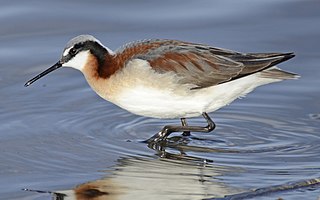
Wilson's phalarope is a small wader. This bird, the largest of the phalaropes, breeds in the prairies of North America in western Canada and the western United States. It is migratory, wintering in inland salt lakes near the Andes in Argentina. They are passage migrants through Central America around March/April and again during September/October. The species is a rare vagrant to western Europe.

Viola tricolor is a common European wild flower, growing as an annual or short-lived perennial. The species is also known as wild pansy, Johnny Jump up, heartsease, heart's ease, heart's delight, tickle-my-fancy, Jack-jump-up-and-kiss-me, come-and-cuddle-me, three faces in a hood, love-in-idleness, and pink of my john.

The banded lapwing is a small to medium-sized shorebird, found in small parties or large flocks on bare ground in open grasslands, agricultural land and open savannah. It is native to Australia and in the past considered as a game bird for hunting. Population estimate is 25 000 - 1 000 000. Other names include banded, black-breasted, brown flock and plain plover.

Calicium is a genus of leprose lichens. It is in the family Caliciaceae, and has 40 species.

The Caliciaceae are a family of mostly lichen-forming fungi belonging to the class Lecanoromycetes in the division Ascomycota. Although the family has had its classification changed several times throughout its taxonomic history, the use of modern molecular phylogenetic methods have helped to establish its current placement in the order Caliciales. Caliciaceae contains 39 genera and about 670 species. The largest genus is Buellia, with around 300 species; there are more than a dozen genera that contain only a single species.
E. tricolor may refer to:
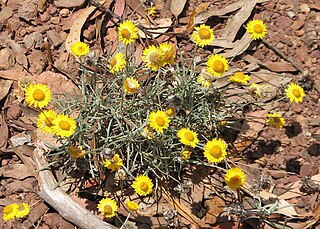
Leucochrysum albicans, commonly known as hoary sunray, is a flowering plant in the family Asteraceae. It is a small perennial with grey leaves, white or yellow flower-heads and is endemic to Australia.

Scarus tricolor, also known as the tri-colour parrotfish or three-coloured parrotfish, is a species of marine ray-finned fish, a parrotfish, in the family Scaridae. It has a wide Indo-Pacific distribution.

Calicium abietinum, commonly known as fir pin or black stubble, is a crustose lichen that is found growing on trees throughout much of the world.
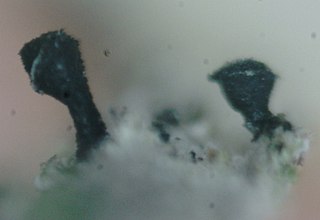
Calicium glaucellum is a crustose lichen that is found growing on trees throughout much of the world. The species is similar to Calicium abietinum.
Calicium laevigatum is a crustose lichen that is found growing on trees in the South West region of Western Australia.
Calicium lenticulare is a crustose lichen that is found growing on trees in the South West region of Western Australia.
Calicium robustellum is a crustose lichen that is found growing on trees in the Gascoyne region of Western Australia and in Queensland.

Calicium salicinum is a crustose lichen that is found growing on trees in the South West region of Western Australia.
Calicium victorianum is a crustose lichen that is found growing on trees and wooden materials.

Calicium viride, commonly known as the green stubble lichen, is a species of pin lichen in the family Caliciaceae, and the type species of the genus Calicium. It is a common and widely distributed species in temperate areas of the Northern Hemisphere and southern South America.

Allocalicium is a single-species fungal genus in the family Caliciaceae. It is monotypic, containing the single pin lichen species Allocalicium adaequatum. This lichen occurs in North America, South America, Europe, and the Russian Far East, where it grows on branches and twigs of deciduous trees and shrubs, typically those of alder and poplar. The species was originally described in 1869 as a member of Calicium, but molecular phylogenetics analysis demonstrated it was not a member of that genus and so Allocalicium was created to contain it.
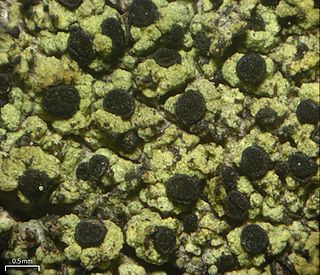
Calicium pinicola is a species of lignicolous (wood-dwelling), crustose lichen in the family Caliciaceae. It is widely distributed in Europe, and also occurs in the United States.
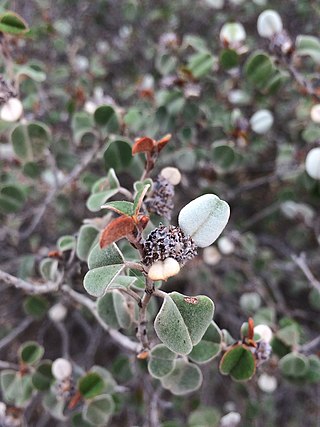
Spyridium tricolor is a species of flowering plant in the family Rhamnaceae and is endemic to southern continental Australia. It is an erect shrub with broadly elliptic to round leaves, and dense clusters of densely woolly-hairy, cream-coloured flowers.











